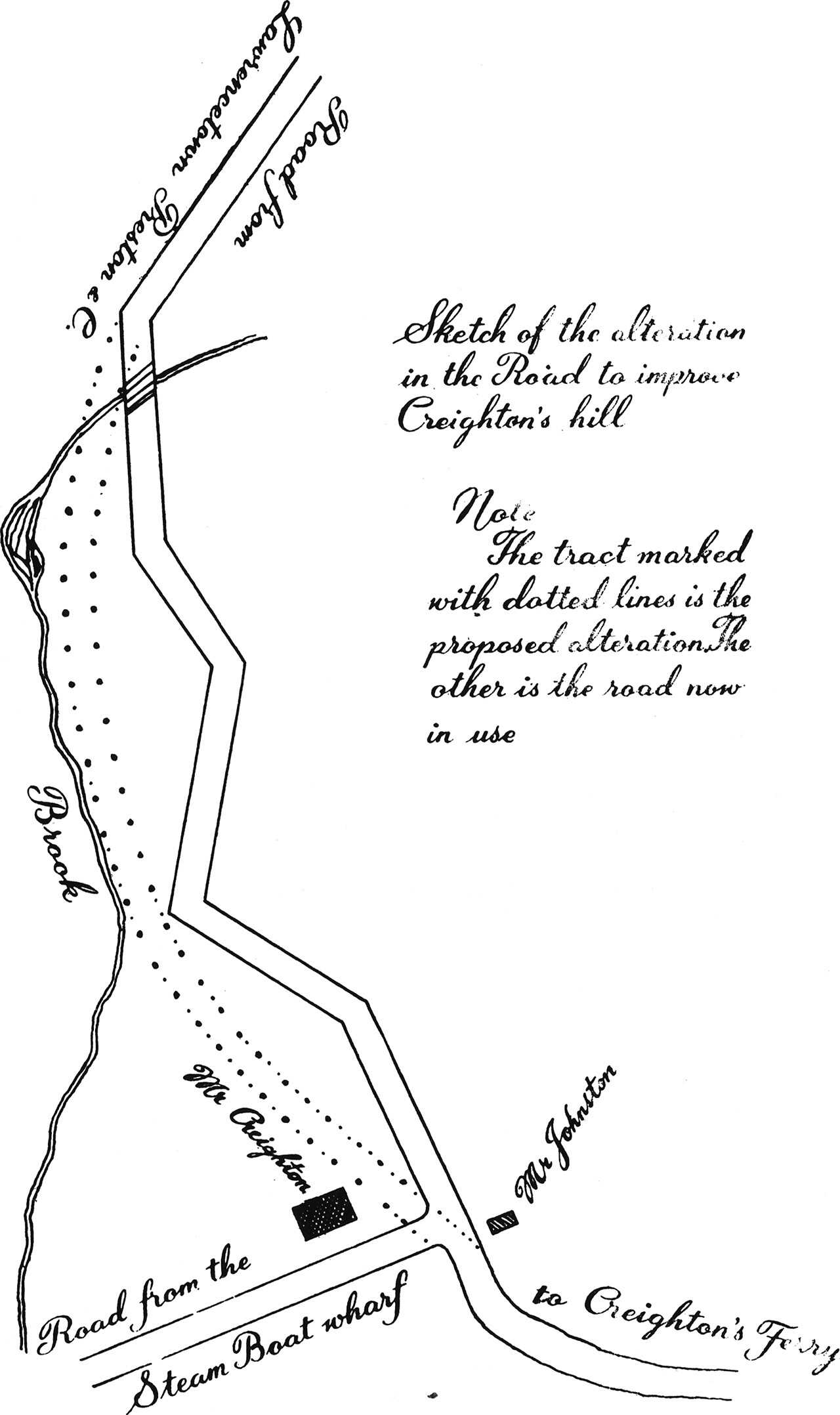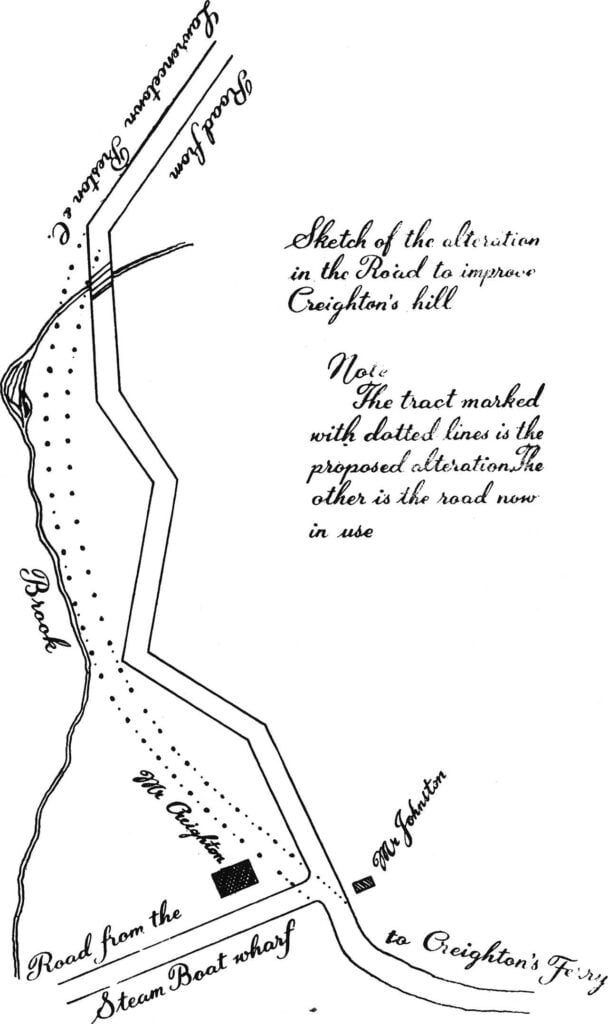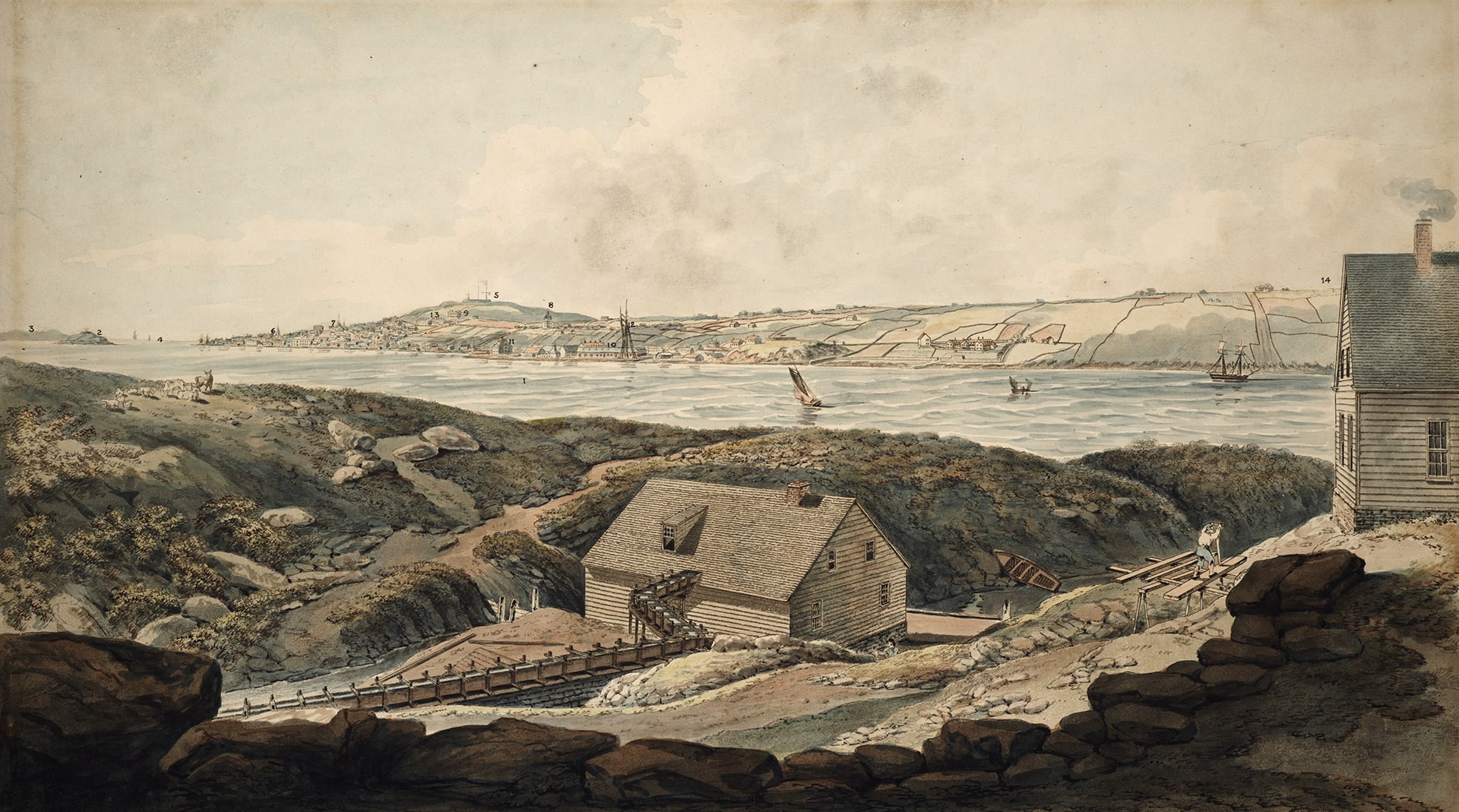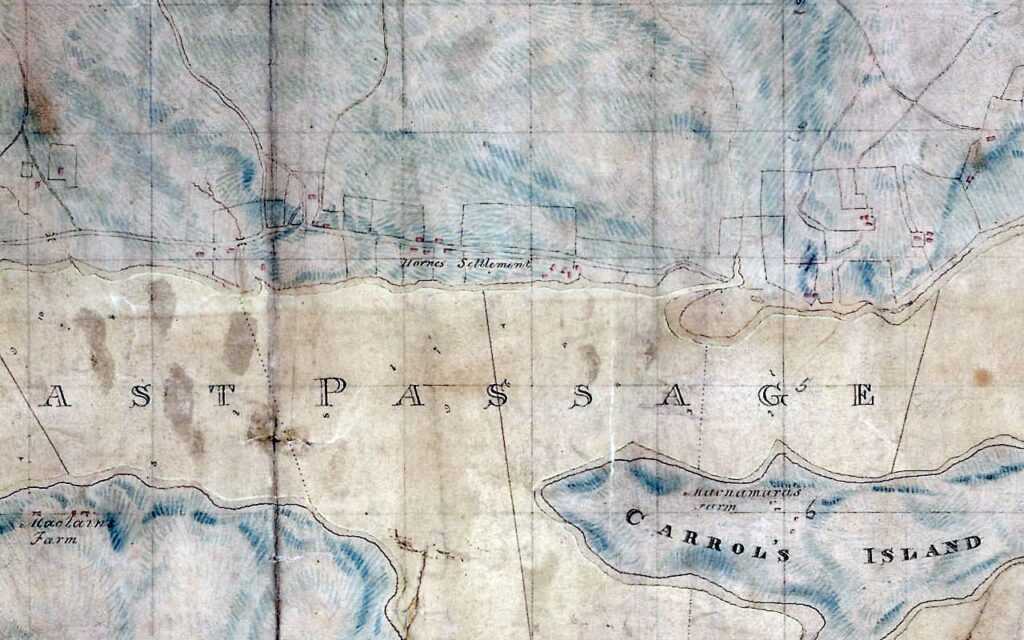From The Story of Dartmouth, by John P. Martin:
The removal of the Nantucket Whaling Company to Dartmouth in 1785, gave the town its first major industry; and also brought about a marked change in the shape of the 1750 town-plot. A local commission of inquiry set up in 1783, ruled that all but two of the Dartmouth proprietors had failed to fulfill conditions of their grants. The Legislature of Nova Scotia voted a considerable sum of money to assist this enterprise, because candles, sperm oil and other products were as essential then, as are gasoline and electricity in our own day.
Most of the houses and lots in the town-plot were then escheated by the Government, and re-allotted to the Nantucketers. This procedure caused much discontent and created disputes over titles for years afterwards.
These Quaker people were industrious. Years ago, old residents used to relate how they could erect a dwelling within a few days. They must have been co-operative. No time was spent in excavating cellars. That they intended to remain permanently, is evident from the spaciousness of their houses and from the fact that they constantly cultivated and improved the soil by grubbing-up tons of our familiar slate-rock to build breast-high stonewalls along the borders of their gardens and orchards.
What is perhaps the last of these walls, still supports the bank at the corner of King and Queen Streets. On that elevation, the Quakers erected Dartmouth’s first house of worship. It was in this building that the Dartmouth Society of Friends made their decision to remove to Wales in 1792. Seth Coleman was clerk.
Houses directly opposite the site of the Meeting House at 63, 65, and 67 King Street, with their very small squared panes of glass over the porches, are typical of Nantucket style. And families still prominent on Nantucket Island, whose ancestors migrated to Dartmouth at the time, include names like Coleman, Coffin, Bunker, Greaves, Swaine, Macey, Ray, Barnard, Leppard and Paddock.
Promoters of the Whaling Company, like Hon. Thomas Cochran of Halifax; and leading Quakers like Samuel Starbuck and Timothy Folger (Foal-jer), got whole blocks of downtown property near Dartmouth Cove. Their idea of reserving Dartmouth Common was to provide grazing-ground for owners of livestock in the town-plot. They builded better than they knew, for the Common has always been the town’s chief recreational centre.
Besides their downtown holdings, Messrs. Folger and Starbuck obtained large tracts in the suburbs. One grant in 1787 comprised 1,156 acres in the present Westphal district. Another of 556 acres bordering Edward Foster’s property, seems to be near the Rope-works. These two men also made application for the swamp land of four acres, which was to be drained and improved for English meadow. Historian George Mullane, writing of this period, calls it the “Folger and Starbuck land grab”.
In the same year that the Quakers left, there occurred the death of Christian Bartling. He was of Danish origin. Despite the fact that he had built a house in the 1750’s, yet his property was escheated for the Nantucket families. Later he obtained Crown grants near Lake Banook. The well-known Walker families of Dartmouth are his descendants.
Another name to note is that of Thomas Hardin (no. 5 Block B). As an illustration of tangled titles and also of the hazardous existence of pioneer Dartmouthians, the following quaint petition of Mrs. James Purcell, dated 1792, is most enlightening:
“To the Hon. Richard Bulkeley,
The humble petition of Mary Purcell, the Grand daughter of Thomas Hardin, most humbly sheweth. That your honor will be pleased to remember that my Grand Father was one of the first settlers in Dartmouth and lived on said place until about 15 years ago. And Bequeathed said Lott of Land to my mother Jean Hardin which served her apprenticeship in Your Honors family and my father Lawrence Sliney likewise, at my Marrying my present husband James Purcell, about four years ago My Mother and Uncle Thomas Hardin Resigned over their Right and Title to us for to subsist our Family- Which is a Lott of Land that was granted by Lord Cornwallis to my Grand Father which he suffered a Vast Deal of Hardship in Clearing and Erecting a House on it. Likewise Lost his Son by the [Mi’kmaq] as he was Obliged to Oppose them by Day and by Night. My husband having registered said Lott pursuant to the Laws of the Province.
But now being informed by a Letter from Mr. Morrice Surveyor General that said Lott is made over by a Grant from his Excellency Governor Par and his Majestys Council to one Cristian Barlet in Dartmouth which has had no Right or Title to said Lott but was to pay to our Family Twenty Shillings Currency a Year. Therefore I Beg and Emplore the favour of your Honour to see me and my poor children Rightified. And will be in duly bound to pray”.
In that same summer of 1792, another menace presented itself. All the munitions for the port were then kept at the Eastern Battery. Several thousand barrels of gunpowder stored in a wooden building near the border of the forest caused considerable alarm, there were frequent fires in the woods. In a petition to the House of Assembly, the inhabitants of Halifax expressed fear for the safety of their town, and asked that the munitions be moved in a more suitable storehouse and in a more remote section.
Hartshorne and Tremaine’s gristmill commenced about this time. The firm purchased the lower mill stream and lands on both sides, where Richard Woodin had his dwelling. They also obtained permission from James Creighton, the proprietor of the upper stream, to lower the bank at the outlet of the lake, and to dam up the river in order to provide a head of water for the millrace.
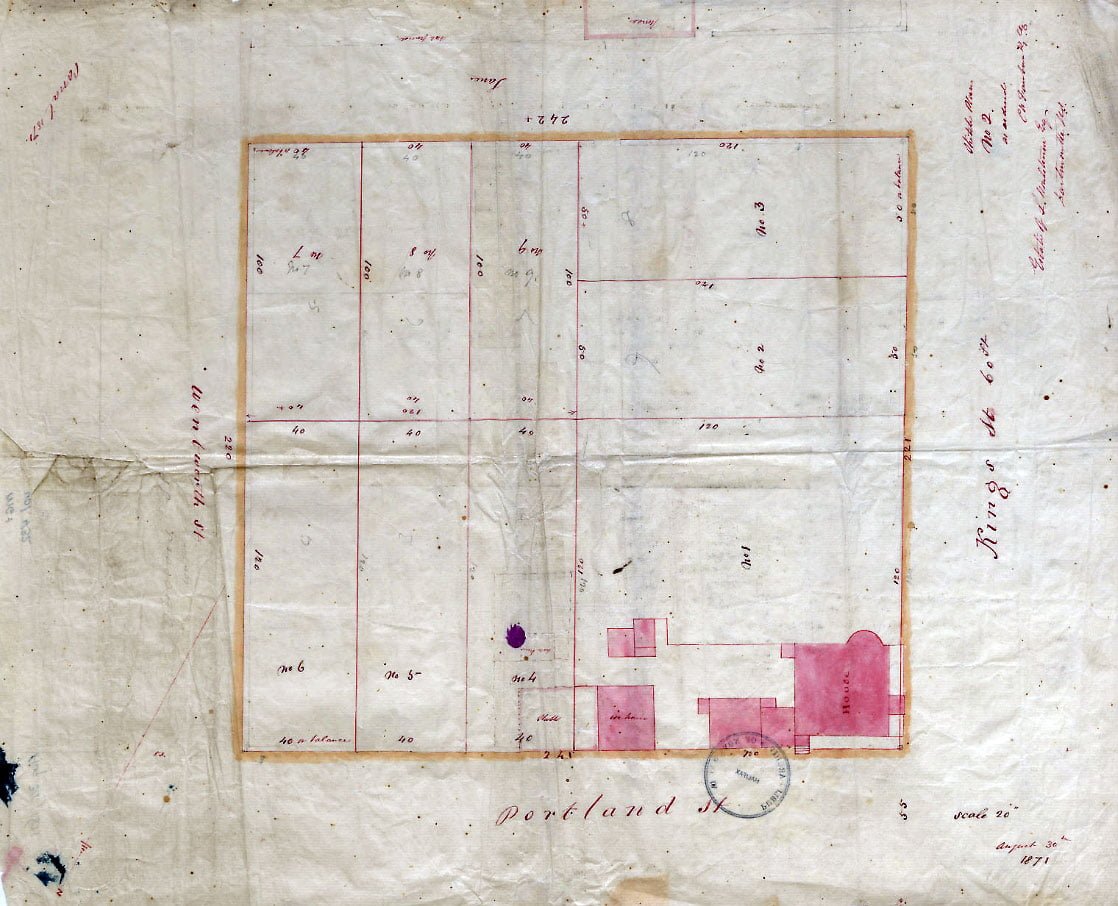
In 1793, Lawrence Hartshorne purchased from Samuel Starbuck, Jr., for £100, the square block “L” bounded by King, Portland, Wentworth and Green Streets. On the old plan it is marked “D”. The lofty tenement building demolished at Woolworth’s corner in 1951, was known a century ago as the “Mansion House” of the Hartshornes. The estate was called “Poplar Hill”.
Jonathan Tremaine acquired the triangular block “M” at Green and King Streets, just below “Poplar Hill”. This had been the property of Samuel Starbuck, senior. But Tremaine’s residence is thought to have been in square block “E”, because he was regranted land at the northeast corner of Portland and Wentworth in 1796, and purchased the remaining lots and buildings in that block from the Starbucks. According to Tremaine genealogy, Jonathan died in 1823 at Dartmouth where he had “a country seat.”
At the same time, the wharves and water-lots left by the Nantucket Whaling Company were also taken over by Hartshorne and Tremaine. For many years this firm had the most extensive flour mill in the Province. Their warehouse was on Water Street in Halifax, whither the finished products were transported by the first vessel built in Dartmouth, “The Maid of the Mill”.
The milling business evidently was profitable in those times, for a third windmill commenced in 1798. An advertisement in the Weekly Chronicle of that year announced that Davis and Barker “have erected a gristmill in Foster’s Cove, and are ready to receive grain to manufacture into flour etc.”
A search through every available record fails to reveal the location of the town-plot ferry-dock during the first four decades of Dartmouth’s history. Certainly the present landing was not the place. The original acclivity of Portland Street can best be gauged by bridging with the eye, the space between the natural heights still seen in the rear of properties on each side of Portland Street, just east of Commercial Street.
The most suitable part of the waterfront for pulling up small boats and erecting cribwork wharves, was on the shelving shore of the crescent-shaped bay which then curved from Queen Street to Church Street. The low-lying land, still seen a few yards west of the Belmont Hotel, indicates that some harbor inlets must have flooded little bays of the original beach now covered with tons of fill leveling the area east of the railway tracks.
During the Quaker period, Zachariah Bunker of the Whaling Company, was located at the southeast corner of Ochterloney and Commercial Streets, where now stands Morris’ Drug Store. On the beach not far from his door he had a water-lot and shed set up, no doubt to ply his trade which was that of a boat-builder.
After the Quakers’ departure, all of Bunker’s town and rural property was bought in 1797 by Dr. John D. Clifford, the ship’s surgeon attached to H.M.S. “Leopard”. Whether Dr. Clifford resided in the corner house is not known, but it was in the above mentioned year that John Skerry commenced his ferry service.
There is no apparent record as to who operated ferries from the 1756 charter of John Rock until Skerry started 40 years later. Perhaps there had not been any organized system, and boats ran privately, for in 1785 a bill was introduced in the Legislature by Hon. Michael Wallace for the establishing of a “public ferry” between Halifax and Dartmouth. This might possibly refer to Creighton’s, or the lower ferry, already mentioned as beginning in the year 1786.
Waterfront plans of those years have Skerry’s dock marked “Maroon Wharf”, which suggests that the foot of Ochterloney Street was the landing-place used by the Jamaica Maroons during the four years that they were billeted at Preston.
Although the story properly belongs to the latter township, yet a brief sketch of the Maroons is included here, because their sojourn in our suburbs stimulated real-estate and transportation activities, and also resulted in the laying-out of a new highway.
The Maroons, deported from the island of Jamaica, arrived in this port in the summer of 1796. For a time they were employed by the Duke of Kent on the Citadel fortifications at Halifax. Later, most of the band were settled at Preston where their superintendents Colonel William D. Quarrell and Alexander Ochterloney bought some 5,000 acres of land with funds furnished by the Government of Jamaica. More was purchased on the Windsor Road near Sackville. In addition, Colonel Quarrell secured several properties in the town-plot of Dartmouth.





